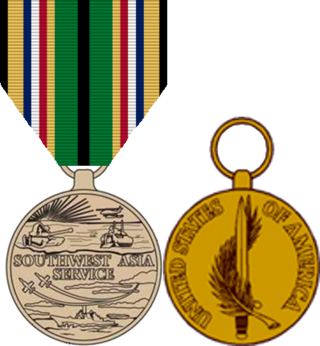The Commendation Medal is a mid-level United States military decoration presented for sustained acts of heroism or meritorious service. Each branch of the United States Armed Forces issues its own version of the Commendation Medal, with a fifth version existing for acts of joint military service performed under the Department of Defense.

Jeremy Michael Boorda was a United States Navy admiral who served as the 25th Chief of Naval Operations. Boorda is notable as the first person to have risen from the enlisted ranks to become Chief of Naval Operations, the highest-ranking billet in the United States Navy.

Command master chief petty officer (CMDCM) is an enlisted rating in the United States Navy and U.S. Coast Guard, as well as the Japan Maritime Self-Defense Force.
The Combat Action Ribbon, is a high precedence United States Navy, United States Coast Guard, and United States Marine Corps military decoration awarded to United States sea service members "who have actively participated in ground or surface combat."

A drill instructor is a non-commissioned officer in the armed forces, fire department, or police forces with specific duties that vary by country. Foot drill, military step, and marching are typically taught by drill instructors.
The Navy "E" Ribbon or Battle Efficiency Ribbon was authorized on March 31, 1976, by Secretary of the Navy J. William Middendorf as a unit award for battle efficiency competition. The service ribbon replaced the "E" patch previously sewn on the right sleeve of the enlisted naval uniform for rates/pay grades E-1 through E-6.
The Achievement Medal is a military decoration of the United States Armed Forces. The Achievement Medal was first proposed as a means to recognize outstanding achievement or meritorious service of military personnel who were not eligible to receive the higher Commendation Medal or the Meritorious Service Medal.
A Sea Service Ribbon is an award of the United States Navy, U.S. Marine Corps, U.S. Coast Guard, the U.S. Army, and the NOAA Commissioned Officer Corps which recognizes those service members who have performed military duty while stationed on a United States Navy, Coast Guard, Army, or NOAA vessel at sea and/or members of the Navy, Marine Corps or Coast Guard who have been forward-deployed with their home unit.
The Fleet Marine Force Warfare Insignia, also known as the Fleet Marine Force badge or FMF pin, are three military badges of the United States Navy which are issued to those U.S. Navy officers and sailors who are trained and qualified to perform duties in support of the United States Marine Corps. There are currently three classes of the Fleet Marine Force pin, being that of enlisted, officer, and chaplain.

The Good Conduct Medal is one of the oldest military awards of the United States Armed Forces. The U.S. Navy's variant of the Good Conduct Medal was established in 1869, the Marine Corps version in 1896, the Coast Guard version in 1923, the Army version in 1941, and the Air Force version in 1963; the Air Force Good Conduct Medal was temporarily discontinued from February 2006 to February 2009, followed by its subsequent reinstatement.

The surface warfare insignia is a military badge of the United States Navy which is issued to U.S. Navy personnel who are trained and qualified to perform duties aboard United States surface warships. There are presently four classes of the surface warfare pin, being that of line, staff, special operations, and enlisted. The line and enlisted surface warfare badges may be earned by United States Coast Guard personnel assigned to Navy commands. The various badge types are as follows:
The Marine Corps Security Guard Ribbon is a United States Marine Corps military award that was established by order of Secretary of the Navy John Howard Dalton on 15 July 1997. The award recognizes those Marine Corps personnel who have served as U.S. Embassy Security Guards and is retroactive to 28 January 1949.

The Southwest Asia Service Medal is a military award of the United States Armed Forces which was created by order of President George H.W. Bush on March 12, 1991. The award is intended to recognize those military service members who performed duty as part of the Persian Gulf War and for a time thereafter. The medal was designed by Nadine Russell of the Army's Institute of Heraldry. The colors of the ribbon are tan, representing sand, with the black, white, red, blue, and green colors symbolizing the colors of coalition countries' national flags.

The Meritorious Service Medal (MSM) is a military award presented to members of the United States Armed Forces who distinguished themselves by outstanding meritorious achievement or service to the United States subsequent to January 16, 1969.
A Drill Instructor Ribbon is a military award of the United States Armed Forces which is issued by the U.S. Navy, U.S. Air Force, U.S. Space Force, and U.S. Marine Corps. The Drill Instructor Ribbon recognizes those service members who are trained and qualified as military instructors to new recruits during initial basic training.

Insignias and badges of the United States Navy are military badges issued by the United States Department of the Navy to naval service members who achieve certain qualifications and accomplishments while serving on both active and reserve duty in the United States Navy. Most naval aviation insignia are also permitted for wear on uniforms of the United States Marine Corps.

The Command at Sea insignia is a badge of the United States' seagoing services worn by officers on their uniforms to denote that they are the commander, or formerly a commander, of a warship. If the wearer is currently the commander of a warship, it is worn above the nametag, which is worn a quarter of an inch above the right chest pocket on a uniform shirt. Afterwards, the pin is moved to the left side of the shirt or jacket. For the commanders of land-based installations, a different but similar version known as the Command Ashore insignia instead.

The uniforms of the United States Navy include dress uniforms, daily service uniforms, working uniforms, and uniforms for special situations, which have varied throughout the history of the navy. For simplicity in this article, officers refers to both commissioned officers and warrant officers.

The United States Navy Ceremonial Guard is the official ceremonial unit of the United States Navy. It is responsible for the performance of public duties in the U.S. Navy. The guard is composed of 200 enlisted navy personnel. It is based at Naval District Washington, Washington Navy Yard, Washington D.C. It is currently led by Commander Dave Tickle.

Awards and decorationsof the Texas Military are medals, ribbons, badges, tabs, trophies, plaques, certificates, memorials, and monuments that recognize service and achievement while serving in the Texas Military Forces.













